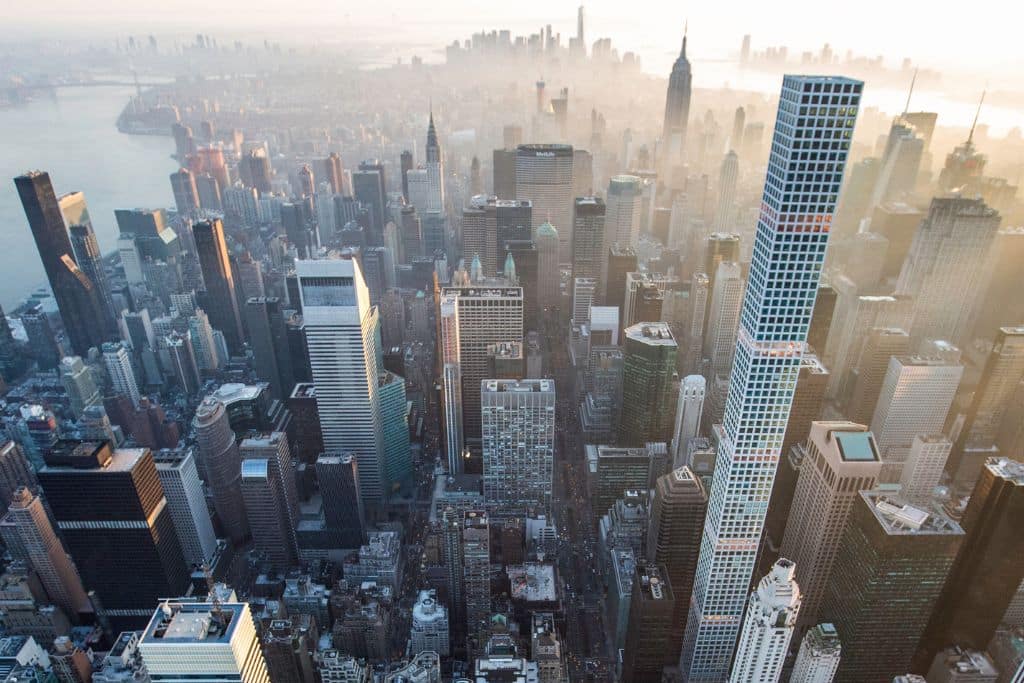Air pollution has been a threat to the well-being of New Yorkers for a long time. The transportation sector, the dominant contributor to emissions in the city, is slowly being modernised and improved. This, along with other sustainable initiatives by the federal and local governments, is improving air quality in the city again. We take a look at the causes and effects of, as well as the potential solutions to air pollution in NYC.
—
Air Pollution in NYC: Causes and Health Implications
According to the American Lung Association, NYC ranks 14th for ozone pollution among all the cities in the United States. Here, greenhouse gas emissions dropped 13% between 1990 and 2016. This is primarily due to energy, industrial and commercial improvements. However, during the same period, emissions increased in the transportation sector, a factor that has contributed to an increase in ozone pollution.

Image 1: New York State Greenhouse Gas Inventory: 1990-2016
Tropospheric or ground-level ozone pollution is caused by the interaction of nitrous oxide (NOx) and Volatile Organic Compounds (VOC) emitted from factories and fossil fuel-powered vehicles. The transportation sector has severely exacerbated the presence of these pollutants in the atmosphere. Annually, ozone pollution in New York City causes around 400 premature deaths, 850 hospitalisations, and around 4,500 emergency visits for health issues such as asthma.
Health issues associated with ozone pollution can be quite severe. According to the American Lung Association and the Environmental Protection Agency (EPA), children, older adults, and individuals with preexisting conditions are among the most vulnerable categories. Studies also suggest that long-term exposure could even lead to increased cardiovascular or respiratory disease mortality. Annually it has been observed that ozone-related mortality rates are quite high in the 65+ age category, while asthma-related hospitalisations are particularly common in children and teenagers.

Image 2: Ozone-related mortality and hospitalisation
NYC’s Transportation Network
Both public and private modes of transport are widely used in the city. The public transit network in New York is one of the most sustainable compared to that of other bigger cities in the country and it helps the city avoid 19 million metric tonnes of emissions per year.
However, transit authorities have pointed out that the use of subways and buses has declined drastically in recent years. According to the Metropolitan Transportation Authority, subway users have dropped from approximately 1.7 billion in 2016 to approximately 760 million in 2021, and bus users went from approximately 639 million in 2016 to approximately 312 million in 2021. The drop has been associated with time delays, improper fund management and lack of upkeep of subways, and slow speeds and delays of buses due to frequent congestion.
Unsurprisingly, a decrease in public transit usage resulted in a rise in the use of private vehicles. The city experienced an 8.8% rise in new registered private vehicles and a 90% rise in the use of app-based ride-hailing services. Inevitably, the surge in cars has caused frequent roadblocks and declining air quality.
Air Pollution in NYC: How Can the City Improve the Situation?
Through the OneNYC 2050 initiative, the local government plans to increase reliance on sustainable transit options. The plan is to prioritise improvements to the subway and bus networks. Among other interventions, authorities are focusing on improving subway accessibility, expanding the network, increasing bus speeds, and improving bus lanes. The OneNYC 2050’s Progress Report published in April 2022 shows some significant progress. Amongst the multiple targets being fulfilled, bus speeds have increased by 25% along with new lanes being added and existing lanes being improved. Subway accessibility has also been improved significantly.
To tackle air pollution in NYC, the government has also introduced a congestion fee – the first of its kind in the United States – with the aim of discouraging the use of motor vehicles. The plan is also to use this money to improve and maintain the public transport network. However, many residents oppose the plan and are sceptical of the motive behind levying the fee. Moreover, Governor Kathy Hochul recently proposed a plan to ban fossil fuel automobiles by 2035 and make the city EV-friendly.
You might also like: New York Becomes 2nd State to Ban Fossil Fuel Cars by 2035
New York has also been experiencing a steady rise in cycling compared to other cities. This surge has unfortunately seen an increase in fatalities. Thus, in order to bring the situation under control and keep cyclists safe, the New York Police Department, the Department of Transportation, and several other institutions have collaborated to improve the overall infrastructure, educate people and introduce laws to make cycling in the city safe and accessible to all. The city now has dedicated bike lanes and a new set of biking laws that make it easier and much safer to cycle around.

Image 3: Green Wave: A Plan for cycling in New York City
The Road Ahead

Image 4: Summertime ozone levels (Note: Ozone measurement is done in the summer when it is often highest compared to other seasons)
In order to limit air pollution, the EPA recommends each state draft its own state implementation plan in accordance with the National Ambient Air Quality Standards (NAAQS). Like any other US state, New York is required to monitor and model air quality, maintain inventories, control strategies for emissions, and document the rules applied to fulfill and maintain NAAQS.
Since December 2008, New York City Community Air Survey (NYCCAS) has been conducting an urban air monitoring programme, providing useful information for the rollout of the OneNYC plan. As can be seen from image 4, the data gathered shows that ozone pollution in the city has decreased over the last decade.
Government officials seem to have a vision for a sustainable future for the city. How these programmes will shape the city and how determined the authorities are to make their visions a reality remains to be seen.
You might also like: How New York Smart City Projects are Leading the Way


















